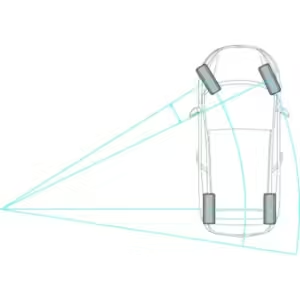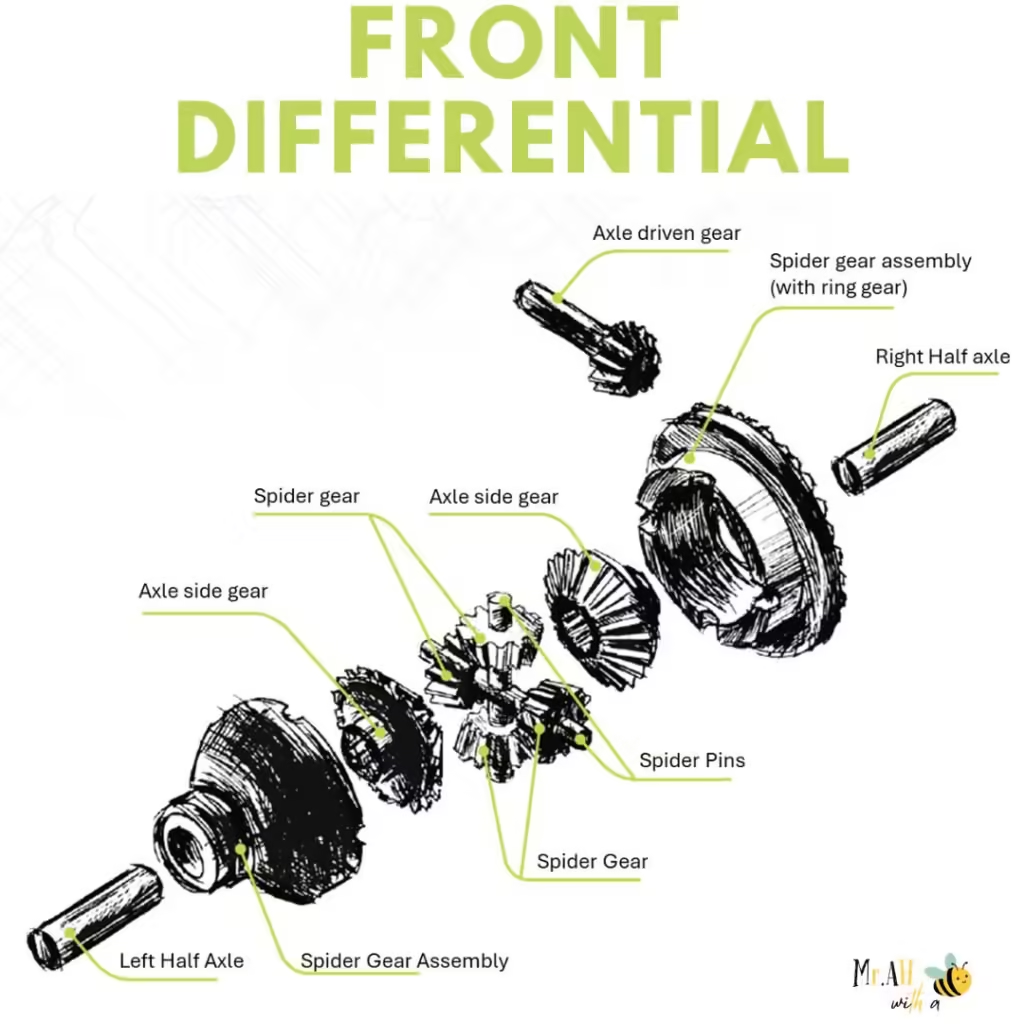Imagine if your car could only move in a straight line—never able to turn left, right, or even go back. You could drive away from home, but returning would be impossible. Fortunately, your vehicle is equipped with a differential, allowing it to navigate corners effortlessly. A front differential is an essential component in many vehicles, especially in front-wheel drive and all-wheel drive systems. It allows the wheels to rotate at different speeds, which is crucial for smooth turns and maintaining control. Discover more about how the differential works, why it’s essential for your vehicle’s performance, and what steps to take if it ever fails.
What is a Differential?
The car differential is an integral part of the axle assembly. It connects to the transfer case or transmission via the driveshaft, channeling the power generated by the engine to the vehicle’s wheels, which enables turning.
This vital component allows a set of wheels to rotate at different speeds. The design of a vehicle’s differential system depends on its wheel drive configuration. For example,
- Front-wheel drive vehicles have a front differential
- All-wheel drive and four-wheel drive vehicles are equipped with both front and rear differentials to distribute power to all four wheels.
The differential regulates the revolutions per minute (RPM) between the left and right wheels, ensuring that torque is evenly distributed. This allows the wheels to respond to varying levels of resistance, providing better traction and facilitating smoother rotation. When there is less resistance, the wheels can rotate faster.
For instance, when turning a corner, the inner wheel may rotate approximately 15 RPM slower than the outer wheel, which rotates about 15 RPM faster than when traveling straight.
It’s important to note that not all vehicles have a differential. For example, go-karts typically have wheels that rotate at the same speed, often using a common axle powered by a chain drive.
Front Differential
The front differential is a key component that connects and regulates the rotation speed of the front wheels. This mechanism is essential for vehicles with front-wheel drive or all-wheel drive systems. Unlike a rear differential, which is commonly found in rear-wheel drive vehicles, the front differential plays a crucial role in managing how power is distributed to the front wheels, ensuring smooth handling and improved traction during acceleration and cornering.
In all-wheel drive vehicles, you may also encounter a center differential. This component is responsible for balancing the power between the front and rear wheels, allowing for optimal performance across varying terrains and driving conditions. The center differential helps to prevent tire slippage and enhances stability by adjusting the torque distribution as needed, enabling the vehicle to maintain traction regardless of whether the road is wet, uneven, or slippery.
Together, the front and center differentials ensure that each wheel can rotate at the appropriate speed, particularly during turns, where the outer wheels need to travel a greater distance than the inner wheels. This coordination not only enhances the vehicle’s maneuverability but also contributes to a safer and more comfortable driving experience.
How the Front Differential Works

Within a front differential, a complex arrangement of gears and axles collaborates to transfer torque effectively to each wheel. This intricate system is designed to accommodate the different rotational speeds required during turns. When you navigate a corner, the differential allows the outer wheel to rotate at a faster speed than the inner wheel. This capability is crucial for preventing slippage and reducing tire wear, ensuring that both wheels maintain optimal traction with the road.
By enabling this smooth transfer of power, the front differential plays an important role in improving the vehicle’s stability and responsiveness during turns. As the outer wheel moves further along its path, the differential compensates for the increased distance traveled, allowing for a more fluid and controlled driving experience. This not only improves handling but also contributes to overall safety by helping the driver maintain control of the vehicle. Moreover, the efficient operation of the front differential also minimizes stress on the tires and suspension components, promoting longer tire life and reducing the likelihood of mechanical issues.
Types of Front Differentials
There are three main types of front differentials:
Open Differential
The open differential is the most common type found in standard vehicles. It provides a basic level of control by allowing the wheels to rotate independently of one another. This setup is particularly effective for everyday driving conditions, as it enables smooth turns and efficient power distribution on dry, even surfaces. However, the open differential can struggle in low-traction situations, such as during rain, snow, or off-road conditions. When one wheel encounters slippery terrain, it may spin freely while the other wheel remains stationary, leading to a loss of power and reduced traction. This limitation can be a significant drawback for drivers who frequently encounter challenging driving environments.
Limited-Slip Differential
The limited-slip differential (LSD) offers a more advanced solution for improving traction compared to an open differential. It allows for some degree of wheel slip, which means that if one wheel begins to spin faster due to a loss of traction, the differential can transfer some of the torque to the wheel with better grip. This feature makes the limited-slip differential ideal for sporty driving, as it enhances cornering performance and acceleration out of turns. It’s also beneficial for off-road driving, where uneven surfaces can lead to one wheel losing traction. By providing a balance between independent wheel rotation and controlled slip, the LSD helps maintain stability and control, making it a popular choice among performance enthusiasts and off-road adventurers alike.
Locking Differential
Locking differentials are typically found in off-road vehicles and are specifically designed for challenging terrains where maximum traction is crucial. When activated, a locking differential effectively locks the two wheels on an axle together, forcing them to rotate at the same speed. This feature is particularly useful in situations where one wheel is on a slippery surface while the other is on solid ground, as it ensures that both wheels receive equal torque. Locking differentials excel in off-road environments, such as mud, snow, or rocky trails, where maintaining traction is essential for navigating difficult obstacles. While they provide exceptional off-road capabilities, locking differentials can be less suitable for on-road driving, as they can create handling difficulties when making sharp turns on pavement. Understanding the different types of differentials can help drivers choose the right system for their specific driving needs and conditions.
Here is a summary of each of the types of front differentials:
- Open Differential: Common in standard vehicles, this type offers basic control but may struggle in low-traction situations.
- Limited-Slip Differential: This design improves traction by allowing some wheel slip, making it ideal for sporty or off-road driving.
- Locking Differential: Usually found in off-road vehicles, this differential locks the wheels together for challenging terrains where traction is essential.
Each type has strengths and weaknesses, depending on performance needs and driving conditions.
Importance of the Front Differential in Vehicle Performance
The front differential plays a major role in handling, stability, and traction. For on-road vehicles, it enables smooth turning, while in off-road or snowy conditions, it provides necessary control and grip. A well-maintained front differential ensures better handling in different environments, from highways to rugged terrains.
Common Issues with Front Differentials
If a front differential fails, the vehicle may exhibit several warning signs. Unusual noises such as whining, grinding, or clunking may occur, particularly during turns. You might also notice that handling becomes more difficult or unstable when cornering. Furthermore, a malfunctioning differential can lead to uneven tire wear, with one tire deteriorating faster than the others. In more serious situations, the differential may seize or lock up, resulting in a complete loss of control over the vehicle.
A failing front differential often produces noticeable sounds. Here are the most common ones:
- Whining: You may hear this noise at different speeds, and its pitch or intensity can vary as you accelerate or decelerate.
- Grinding: This is a more serious symptom that typically indicates significant wear or insufficient lubrication.
- Clunking: This sound is usually noticeable when starting, stopping, or shifting gears, suggesting there is play in the differential’s components.
- Humming or Rumbling: These noises may indicate worn bearings or gears.
It’s crucial to diagnose and address these sounds promptly to prevent further damage.
Common causes of Issues
- Worn-Out Bearings: Over time, the bearings in the differential can wear down, resulting in noises such as humming or grinding. This wear can also lead to misalignment of the gears.
- Low or Contaminated Fluid: Differential fluid plays a crucial role in lubricating and cooling the components. If the fluid level is low or if it becomes contaminated, it can cause overheating, increased friction, and accelerated wear of the components.
- Damaged Gears: Gears within the differential can become chipped, broken, or misaligned. This damage often leads to grinding noises, diminished performance, and, in severe cases, a complete failure to transfer power effectively.
- Faulty Seals: When the seals within the differential degrade or fail, they can create fluid leaks. This results in reduced lubrication and cooling, potentially leading to a host of related issues.
- Improper Alignment or Installation: If the differential components are not properly aligned or if the unit is incorrectly installed, it can cause vibrations, premature wear, and inefficient power distribution.
Common Fixes for Front Differential
- Fluid Change: Replacing old or contaminated differential fluid is essential for maintaining proper lubrication. This helps reduce friction and prevents premature wear of the internal components.
- Bearing Replacement: Replacing worn-out bearings helps restore smooth operation, minimizes noise, and prevents potential misalignment of the gears within the differential.
- Seal Replacement: Changing faulty seals eliminates fluid leaks, ensuring that the differential remains properly lubricated and operates at optimal temperatures.
- Gear Replacement or Adjustment: Repairing or replacing damaged or misaligned gears restores the differential’s capability to distribute power efficiently, effectively reducing grinding or clunking noises.
Maintenance and Care for Front Differentials
To keep your front differential in good condition:
Conduct Regular Fluid Checks and Changes
It’s essential to routinely check the differential fluid levels and condition. Regular inspections can help you identify any signs of contamination or depletion. Additionally, make sure to change the differential fluid according to the manufacturer’s recommended intervals. This practice ensures optimal lubrication and cooling, which are crucial for the longevity and performance of the differential.
Monitor for Leaks and Unusual Noises
Be vigilant in inspecting your vehicle for any signs of fluid leaks around the differential. Look for wet spots or puddles underneath the vehicle, as these can indicate a problem. Also, pay attention to any unusual sounds, such as grinding, whining, or clunking, while driving. Noticing these signs early can help you diagnose issues before they escalate into more serious problems.
Address Minor Issues Promptly
If you detect minor problems, such as small leaks or unusual noises, it’s important to address them as soon as possible. Ignoring these early warning signs can lead to more significant damage and costly repairs down the line. By taking timely action, you can ensure that your differential remains in good condition, ultimately extending the life of your vehicle and improving its overall performance.
Upgrading Your Front Differential
Enhancing your front differential can significantly improve both traction and durability, particularly for off-road enthusiasts or individuals looking to maximize their vehicle’s performance. Upgrading to a limited-slip differential can provide better control and stability by allowing for some wheel slip while still transferring power efficiently to the wheels that have the most grip. This is especially beneficial in challenging driving conditions, such as muddy trails or slippery surfaces, where maintaining traction is crucial.
For those who engage in off-road driving, a locking differential may be an even more advantageous upgrade. This type of differential locks the two wheels on an axle together, ensuring that both wheels receive equal torque. This is particularly useful in rugged terrain, where one wheel often rests on solid ground while the other encounters an unstable surface. By locking the wheels, you can navigate obstacles more effectively, enhancing your vehicle’s off-road capabilities.
Even for daily drivers, upgrading the front differential can yield significant benefits. Routine upgrades that focus on improving durability can lead to enhanced efficiency and longevity of the vehicle. Stronger differential components can withstand the rigors of everyday driving, reducing the risk of wear and tear over time. This not only improves performance but can also lead to lower maintenance costs in the long run.
FAQs
- What is a front differential?
A front differential transfers power to the front wheels, allowing them to rotate at different speeds during turns. - How far apart are front differential inspections recommended?
Regularly inspect your differential every 30,000 to 50,000 miles or as advised by your vehicle’s manual. - What are the signs of a failing front differential?
Common signs include grinding noises, leaking fluid, and vibration while turning. - Can a front differential be upgraded?
Yes, you can upgrade it to improve traction, especially for off-road or performance driving. - How often should the differential fluid be changed?
Typically, every 30,000 to 60,000 miles, depending on driving conditions and vehicle type.
Thanks for reading, for more interesting articles, visit our homepage.



